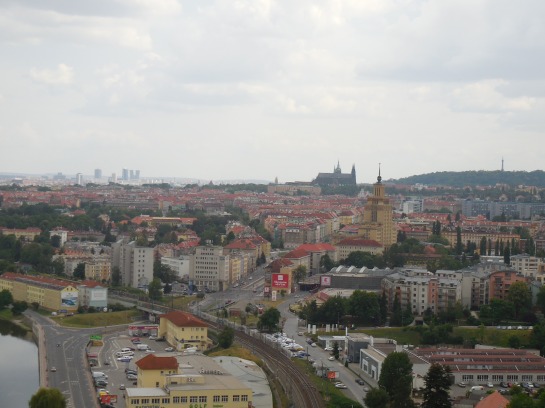
View from Baba with St. Vitus’ Cathedral in the background
I like to take walks through the functionalist Baba colony in Prague’s sixth district, an area made up of 33 individual family homes constructed during the early 1930s in what was then the democratic First Republic. Pavel Janák, who worked for many years as the main architect of Prague Castle, was in charge of creating the housing development, and he had help from several other notable personalities in his field. The houses, whose designs were influenced by the Bauhaus style, were built for historians, writers, translators, publishers, sociologists, university professors, doctors and public officials who worked in ministries, to name a few.

Many of the homes have been built into steep, sloping terrain on what was once farmland. It never ceases to fascinate me how the functionalist designs can complement the natural setting, using the location as a lively architectural element. The architects worked with the natural elements rather than against them. I also noted that there was a clear division between house and garden. In fact, in many cases, the gardens are not directly accessible from the buildings. I would have loved to have stood on some of those terraces and balconies; I am sure they offer stunning views, but I could only see the houses from street level.

Typical for functionalism, the exteriors boasted no frills, and no experimental materials were used. Most houses were constructed of concrete and/or iron, for instance. The flooring often consisted of xylolite or linoleum. Many of the houses had central heating. While I could not go inside as they are all privately owned, I read that the interior walls in many of these abodes were white. Still, many of the interiors boasted unique features.
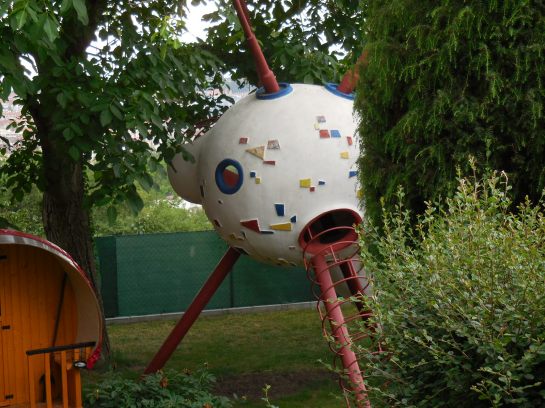
Sputnik playground equipment, once in Stromovka Park
The Home of the Palička family is notable for the placement of its terrace on the ground floor instead of on the roof. In the garden of this house, there is a unique piece of equipment from a playground, a colorfully dotted, plastic contraption called Sputnik. It used to be in Stromovka Park during the 1960s. When the equipment was deemed unsafe for children, it was removed from the park. Now it serves as a relic of times past, displayed prominently in the tranquil garden.

Cyril Bouda from Artmuseum.cz

Illustration by Cyril Bouda for a children’s book
Installed in the House of Cyril Bouda, a prominent illustrator, painter and professor, was a studio with unique features. The living room was connected with the studio by a sliding wall. From the two-floor studio, there was an exterior staircase leading to the garden. Janák designed the House of Karel Dovolil, which features a steel staircase connecting the garden to the terrace. Janák’s creation for Václav Linda and Pavla Lindová featured a stepped terrace above the garage. The House of Jan Bělehrádek and Marie Bělehrádková boasts four sections on four levels. The entrance is underground, on the second level. Looking at the façade, it is evident that the architect used the terrain as a contrasting element. The walls of the house are smooth, in stark contrast to the rather rough, sloping ground.

Josef Gočár from Brněnský architektonický manuál
Josef Gočár, who was responsible for four houses, designed the House of Julius Glucklich, which boasted an intriguing interior that looked like one continuous space. The hall and dining room were only separated by a sliding wall, a characteristic I also mentioned in another example. The House of Marie Mojžíšová and Stanislav Mojžíš, designed by Gočár, featured a Raumplan design, a design created by famous Czech-Austrian architect Adolf Loos. The Raumplan structure meant that each room was on a different level. The House of Václav Maule and Jarmila Mauleová, another masterfully built edifice by Gočár, features bedrooms situated on a raised ground floor while the living room is located on a higher level, perched on corbels. I would love to see the splendid views from that living room!
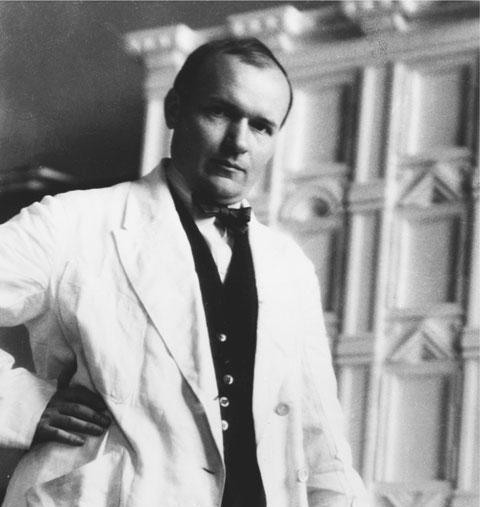
Pavel Janák from Brněnský architektonický manuál
What to me is even more interesting than the architecture of the homes are the stories of the lives of their occupants. Admittedly, I am not the biggest fan of functionalist architecture, but I would have loved to have been a fly on the wall in some of these houses.

The Munch couple had a house with both an exterior and interior staircase. Náďa Munková had served as personal secretary to Alice Masaryková, a daughter of the first Czechoslovak president, Tomáš Garrigue Masaryk. I wonder what it was like to work with Alice and how often she saw or spoke with Alice’s father, one of the heroes of the Czech nation. I often wonder what it would be like to live during Czechoslovakia’s First Republic, which was short-lived, only lasting from 1918 to 1938. I would have loved to have met both Alice Masaryková and President Masaryk. Náďa and her husband František emigrated to the USA in 1939, the year the Nazis took over Bohemia and Moravia. František studied and worked at Harvard and Columbia for a time.

Václav Řezáč
Vaclav Řezáč, whose house was built by František Kerhart during 1932 and 1933, made a name for himself as a writer who became successful in the 1930s by penning books for children. His best work, The Almanach of the Czech Book, was published during World War II, when the Nazis had control. He also began writing psychological novels during that era and received many accolades. His novel Black Light also became a film in which legendary Czech actor Josef Abrham played the lead role. I most admired Abrham for his role as the pickpocket pretending to work as a waiter in Run Waiter, Run!, the first screenplay that Zdeněk Svěrák wrote. Řezáč worked as an editor for the daily Lidové noviny from 1940 to 1945 and then took up screenwriting. A lot of his screenplays were made into films, some even under the Nazi Protectorate. For many years, he was the director of the state publishing house, Československý spisovatel.

After the Communists took control in 1948, Řezáč took a strong social realist stance in his writings, promoting totalitarian ideology. I wondered if he had believed in Communism or had been pressured into becoming a mouthpiece for the regime. Maybe both? Every day I was grateful that I had not had to endure living under Communism. I had heard enough stories from my friends who grew up during totality. Hearing those tales, I felt as if Communism was something that was almost tangible, while growing up during the Cold War in the USA I had considered it to be something gray and murky, something that existed far away, in a place I would never go.

Cyril Bouda, who had lived in the area, was such a significant artist in the Czech lands during the First Republic that he nabbed many awards. From 1946 to 1972, he was a professor at Charles University. One of his students was Jaroslav Weigel, who I have seen act many times on the stage of the Žižkov Jára Cimrman Theatre, one of my favorite places in the world. Weigel also worked as a painter, graphic artist and screenwriter. I had always thought of him as an actor before reading about his life. I hadn’t realized he was a man of so many talents.
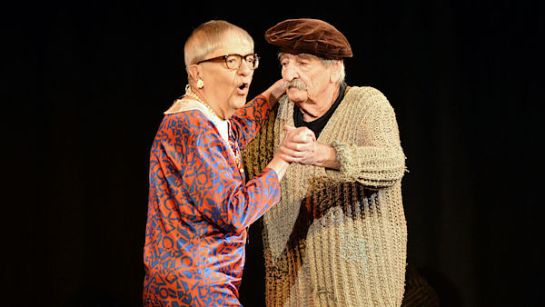
Miloň Čepelka as Mrs. Žilová and Jaroslav Weigel as Mr. Žila in the Jára Cimrman Theatre’s first play, Akt
Bouda was known mostly for his graphic art and illustrations in books. He often illustrated fairy tales and legends as well as humorous and historical books. Bouda also designed some Czechoslovak stamps and a stained glass window in Saint Vitus’ Cathedral. He created a tapestry of the capital city for the Hotel Intercontinental in 1958. He was dubbed a National Artist in 1976, when the rigid normalization era of Communism was in full play. A year later, he signed the anti-Charter that opposed Charter 77, a document calling for human rights. I wondered if he had been pressured to sign the anti-Charter or if he really was against Charter 77, which was created by dissidents, including Václav Havel. I know many artists signed the anti-Charter under pressure from the regime. They must feel very guilty now for having signed it back then. I imagine it is a part of their past of which they are ashamed. But, during Communist times, things were not always black-and-white. Then again, life is full of grey areas, no matter what era you live in.

Antonie Suková and Václav Suk had a house in Baba, too, designed by Hana Kučerová – Záveská, whose architectural signature appears on two homes. It stood out as the largest house in the area, and the design had been in part influenced by Corbusier. Suk was arrested by the Communists at the end of the 1950s, an especially dark decade for Czechoslovakia. He passed away while behind bars. Unfortunately, his story is not unique.

The amazing athlete Jan Zadák had a house with folding wooden blinds, which were characteristic for functionalist creations in the early-to-mid 1930s. He competed in nine sports, but for fun played another 21 as well. I would love to have his stamina and to have been that fit. As a child, I had played baseball with boys and ice hockey with boys and girls. Some of my favorite afternoons involved taking part in a hockey practice followed by a baseball practice, being able to participate in two sports during one day. Zadák was especially known as a soccer goalie who became a referee when he retired. He played for Kolín and then for Sparta Praha, a famous team in the Czech lands. Even though he was so fit, he died at the early age of 66 in 1954.

The occupants of the house with the stepped terrace garden, Václav Linda and Pavla Lindová, did not have easy lives, even though their home was architecturally impressive. Still, luck had been on their side in the end. Pavla was Jewish but was not ushered away to a concentration camp because her husband was not Jewish. The couple’s son, however, had to toil in a work camp during the Second World War. In 1968, during a more liberal time of Communism, the family emigrated to the United States.

Stanislav Mojžíš served as director of the National Theatre when his house was built by Gočár during 1935 and 1936. The living room was very lavish with its fireplace and three big windows. He worked as director from 1932 to 1939, the year the Nazis marched into Prague. He also penned poems, historical plays, feuilletons and essays. He often used the name Stanislav Lom instead of his birth surname.
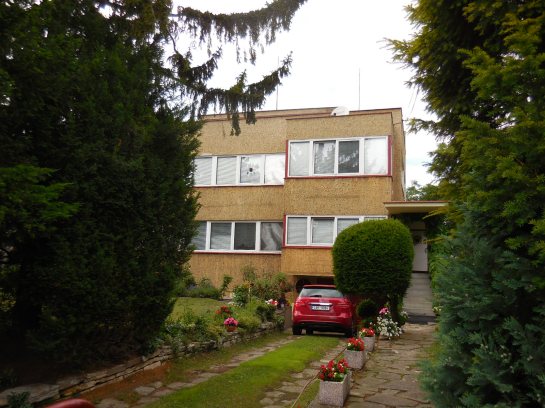
Jan Bělehrádek’s work centered on medicine and biology. While living in Prague, he taught at Charles University. During the 1930s, as a resident of Baba, he aided anti-Fascist endeavors and even chaired the underground Czech organization, We Remain Loyal. I wondered if he had been paranoid every day that the Nazis would come to his door and take him away forever. When it seemed that the Nazis would harm his family, he scarpered off to a sanatorium on the pretense of having tuberculosis, though his illness was purely fabricated. His ruse was not successful in the end, though. In 1945, the Nazis deported him to the Czech work camp Terezín. He was lucky. He came back alive. During the Second democratic Republic of Czechoslovakia, he served as rector of Charles University. Bělehradek fled to Paris after the Communists took control in the late forties. However, his family was not able to escape with him. Finally, in 1951, he was reunited with his family abroad. He wound up working for UNESCO and settling in London.

Karel Kytlica, the occupant of a house accented by terraces and a garden with a pergola, was a hero to many during World War II. Employed by the Ministry of Education and fluent in German, Karel was able to keep many of his employees safe and out of work camps. Karel was no fan of Communism, either. He refused to join the Party in 1948. He wound up training dogs after retiring as an invalid.
Václav Maule played significant roles as a translator, writer and publisher during the First Republic. He was incarcerated in Terezín but escaped at the end of the war. His freedom was short-lived, however. Three weeks later, he died of typhus.

Janák had built a house for himself in Baba, too. I sometimes visited Janák’s grave in the cemetery of the Church of St. Matthew in Hanspaulka, a part of Prague’s sixth district next to Baba This prominent architect of Czech modernism style had put his John Hancock on the city of Prague. In the capital city, he not only reconstructed buildings at Prague Castle but also designed two bridges, villas in the Střešovice district, a Cubist kiosk in a park, the Adria Palace, the Škoda Palace and the Juliš Hotel. He carried out reconstruction on Černín Palace, the home of the Ministry of Foreign Affairs, and Old Town Hall. He was also interested in art and founded the Artěl movement of handicrafts. He designed many objects and much furniture in this style. It was after 1925 that he changed from a decorative style and took up functionalism and urbanism. He also designed pavilions at the Jubilee Exhibition of 1908 and the pavilion for Czechoslovakia at an exhibition in Rio de Janeiro during 1922.
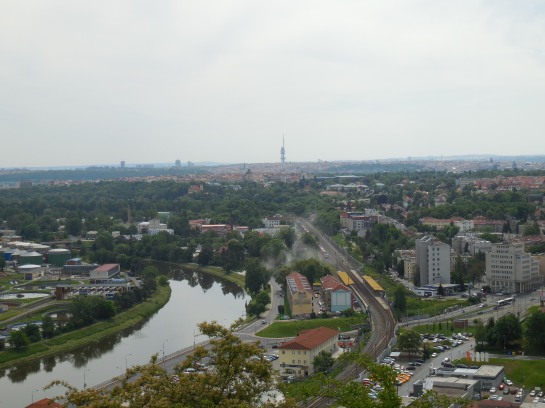
View from Baba
While Janák’s works dotted Prague, Gočár made a name for himself in Hradec Králové and Pardubice. He was known for his creations in Cubist style before taking up functionalism and urbanism. He studied under the tutelage of well-known Czech architect Jan Kotěra. Gočár served as a professor of the Academy of Decorative Arts in Prague until 1939 and for a time also was the school’s rector. In Prague he is best known for designing the Rondocubist Legio Bank and the Cubist House of the Black Madonna, which had housed a museum of Cubism for many years. The café there was Cubist, too, a real architectural gem. Gočár also designed gravestones.
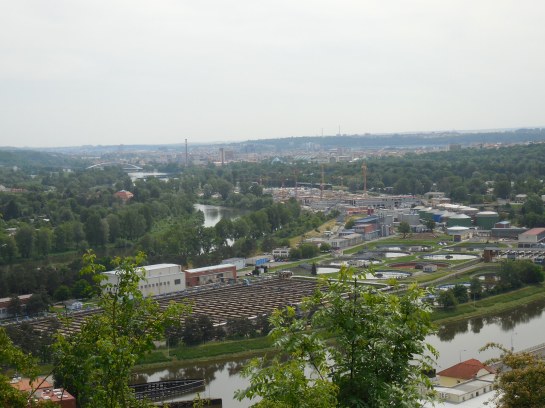
View from Baba
Baba is not only architecture; it is people, the people who spent their everyday lives in the functionalist development, those who had experienced joy and hardship. I loved the stories those houses could tell. It was as if I could almost hear them whispering to me as I perused the exteriors. Walking through Baba is one of my favorite activities on a pleasant day. Now maybe you can understand why.
Tracy A. Burns is a writer, proofreader and editor in Prague.


St. Vitus’ Cathedral as seen from Baba